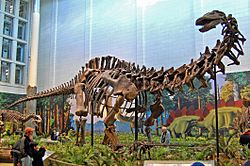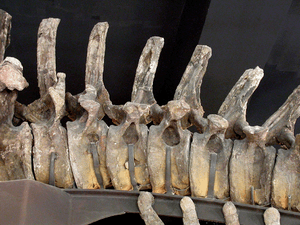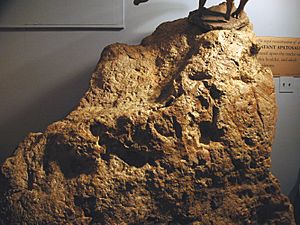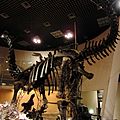Apatosaurus facts for kids
Quick facts for kids ApatosaurusTemporal range: Upper Jurassic
|
|
|---|---|
 |
|
| A. louisae skeleton, Carnegie Museum | |
| Scientific classification | |
| Kingdom: | |
| Phylum: | |
| Class: | |
| Superorder: | |
| Order: | |
| Suborder: | |
| Infraorder: | |
| Family: | |
| Genus: |
Apatosaurus
Marsh, 1877
|
Apatosaurus is a sauropod dinosaur which lived in the Upper Jurassic period. It is in the same family as Diplodocus. Brontosaurus was once thought a later name for Apatosaurus, but is now proved to be a separate genus.
Apatosaurus grew as big as 21 meters long, 4.5 meters tall at the hip, and weighed up to 23 metric tons. It ate plants. Its bones have been found in Wyoming, Colorado, Oklahoma, and Utah.
When it was first found, scientists thought that Apatosaurus lived partly under water, since it could not hold its own weight on dry land. Now they think it lived on dry land, probably in herds.
The cervical vertebrae were less elongated and more solid than those of Diplodocus. The bones of the leg were much stockier (despite being longer), implying a more robust animal. The tail was held above the ground during normal locomotion. Like most sauropods, Apatosaurus had only a single large claw on each forelimb, with the first three toes on the hind limb possessing claws.
There are at least two species of Apatosaurus:
- A. ajax was discovered by Othniel Charles Marsh in 1877.
- A. louisae was discovered by William Holland in 1915.
- Another dinosaur species discovered in 1994 was at first named A. yahnahpin, but in 1998, it was renamed Eobrontosaurus yahnahpin.
Lifestyle
It was believed throughout the 19th and early 20th centuries that sauropods like Apatosaurus were too massive to support their own weight on dry land. It was theorized that they lived partly submerged in water, perhaps in swamps. Recent findings do not support this. Sauropods are now thought to have been fully terrestrial animals. A study of diplodocid snouts showed that the square snout, large proportion of pits, and fine, subparallel scratches of the teeth of Apatosaurus suggests it was a ground-height, nonselective browser. It may have eaten ferns, cycads, seed ferns, horsetails, and algae.
Important issues like heat control, metabolic rate and respiration are still unclear. Some scientists state that the heart would have had trouble sustaining sufficient blood pressure to oxygenate the brain. Others suggest that the near-horizontal posture of the head and neck would have eliminated the problem of supplying blood to the brain because it would not have been elevated.
James Farlow calculates that an Apatosaurus-sized dinosaur about 35 t (34 long tons; 39 short tons) would have had 5.7 t (5.6 long tons; 6.3 short tons) of fermentation contents (food being digested). "The heat of fermentation may have been a significant source of thermoregulatory heat for these reptiles".
Images for kids
-
Comparison of A. ajax (orange) and A. louisae (red) with a human (blue) and Brontosaurus parvus (green)
-
Cervical vertebra of A. ajax (holotype, YPM 1860) in side and anterior view
-
Apatosaurine mount (FMNH P25112) in the Field Museum of Natural History in the 1950s, with its original, inaccurately reconstructed skull
-
Saurophaganax and A. ajax, Sam Noble Oklahoma Museum of Natural History
See also
 In Spanish: Apatosaurus para niños
In Spanish: Apatosaurus para niños















